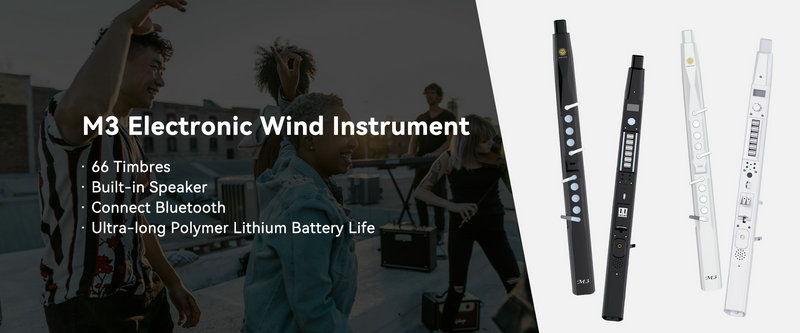When choosing the right cable and connector for an electronic wind instrument, the following points need to be considered:
Cable Type:
MIDI Cable: If the electronic wind instrument needs to transmit MIDI data to an external device such as a synthesizer or a computer, a MIDI cable is required. MIDI cables are typically round and have 5-pin DIN connectors at both ends. Make sure to choose a MIDI cable with good quality and shielding to ensure stable data transmission and minimize interference.
Audio Cable: If the electronic wind instrument needs to output audio signals to an amplifier, speaker, or recording device, an audio cable is needed. Audio cables come in various types, including analog audio cables (such as RCA cables, 3.5mm stereo cables, or 6.35mm mono/stereo cables) and digital audio cables (such as USB cables or optical cables). The choice of audio cable depends on the specific audio output interface of the electronic wind instrument and the input interface of the external device. For example, if the instrument has a 3.5mm headphone jack output and you want to connect it to a home stereo system with RCA inputs, you would need a 3.5mm to RCA cable.
Power Cable: Some electronic wind instruments may require a power cable to operate. Ensure that the power cable is compatible with the instrument's power requirements and that it is of good quality to avoid power supply issues.
Cable Quality:
Shielding: Look for cables with good shielding to reduce the pickup of external electromagnetic interference (EMI) and radio frequency interference (RFI). This helps to ensure clean and noise-free signal transmission. Cables with braided or foil shielding are generally better at reducing interference compared to unshielded cables.
Conductor Material: Higher quality cables often use better conductor materials such as oxygen-free copper (OFC) or silver-plated copper. These materials offer lower resistance and better signal conductivity, resulting in improved sound quality.
Durability: Consider the durability of the cable, especially if it will be used frequently or in a mobile setup. Cables with thicker jackets and reinforced connectors are more likely to withstand wear and tear.
Connector Type and Compatibility:
Connector Size and Shape: Ensure that the connectors on the cable match the corresponding ports on the electronic wind instrument and the external device. Common connector sizes for audio include 3.5mm (mini-jack), 6.35mm (quarter-inch), and RCA. For MIDI, it is the 5-pin DIN connector. Make sure the connectors fit snugly and securely to avoid signal loss or intermittent connections.
Gender and Polarity: Check the gender (male or female) and polarity of the connectors. For example, a male 3.5mm connector should plug into a female 3.5mm jack. Some connectors may also have specific polarity markings or keying to ensure correct insertion.
Compatibility with Devices: Verify that the connectors are compatible with the specific models and brands of the electronic wind instrument and the external device. Some devices may have proprietary connector types or require adapters for certain connections. It is advisable to consult the user manuals or product specifications of both devices to ensure compatibility.
Length and Flexibility:
Length: Consider the length of the cable based on your usage scenario. If you will be using the electronic wind instrument in a stationary setup near the connected device, a shorter cable may be sufficient. However, if you need more freedom of movement or if the instrument and device are located at a distance from each other, a longer cable may be necessary. Keep in mind that longer cables may introduce more signal loss and potential for interference, so it is important to balance the length with signal quality requirements.
Flexibility: A flexible cable is easier to manage and route, especially in tight spaces or when the instrument is being moved around. Look for cables that are not overly stiff or bulky to ensure ease of use.
Additional Features:
Gold-Plated Connectors: Some cables may have gold-plated connectors, which can offer better corrosion resistance and improved signal transfer. However, the impact of gold plating on sound quality may be negligible in most cases, and it often comes at a higher cost. Consider whether the added expense is justified based on your specific needs.
Twisted Pair or Coaxial Construction: Certain types of cables, such as some MIDI cables or high-quality audio cables, may have a twisted pair or coaxial construction. These designs can help reduce crosstalk and interference between different signal paths within the cable, resulting in better signal integrity.
Brand and Reputation: Choose cables from reputable brands known for their quality and reliability. Well-known brands often have better quality control and customer support, which can give you more confidence in the performance and durability of the cable. Reading reviews and seeking recommendations from other musicians or audio professionals can also be helpful in selecting a reliable cable.
By considering these factors, you can choose the right cable and connector for your electronic wind instrument to ensure optimal signal transmission, sound quality, and compatibility with your external devices. If possible, it is also a good idea to test the cable and connector with your specific setup before making a final purchase to ensure that they meet your requirements. Additionally, if you have any doubts or questions, it is advisable to consult with a professional audio technician or the manufacturer of the electronic wind instrument for further guidance.
SUNRISE MELODY M3 Electronic Wind Instrument - The best-selling Electronic Wind Instrument
. 66 Timbres
. Built-in Speaker
. Connect Bluetooth
. Ultra-long Polymer Lithium Battery Life



